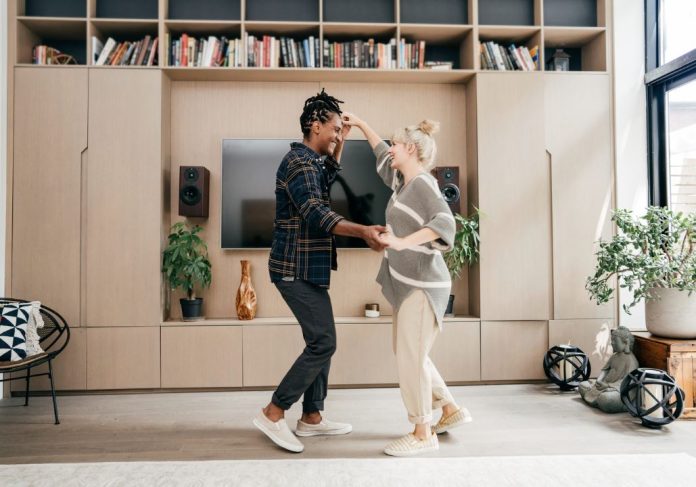We want our home to be a haven of light and warmth, welcoming to all who enter. We spend a lot of time picking the right paint, the right furniture, and the right accessories to make our houses feel like home. We want everyone who lives there to have their personalities shine through in different spaces while creating an atmosphere of light, life, and love throughout the rooms of your home.
We’ve all been in spaces that feel dark, negative, and cramped. You might have walked into a space and felt claustrophobic or jittery, simply because there was negative or chaotic energy present there. There is a lot we can do to decrease the negative energy in the spaces we live and work in by allowing positivity and good energy to flow.
Here are a few things we know about color and how different hues can change the atmosphere of your room.
Blue: Blue is a color that exudes warmth, tranquility, and relaxation. Blue should be used in rooms where you want to emphasize calm and healing energy.
Green: We associate green with nature as it symbolizes growth and new life. Green is associated with memories and new beginnings and can be used in rooms where you want to feel nourished and refreshed.
Red: Red is a vibrant color, perfect for passionate spaces. Red gets our blood flowing and makes us excited. Red is an intense color and should be used strategically.
Yellow: Yellow is a warm, bright, and happy color, perfect for accent walls and other accents that can be used to make spaces feel bigger. Yellow is cheerful, happy, and playful. Yellow can be used in any room of your house to promote stimulation.
Violet: Violet is a spiritual color used to promote intuition. This color is good for spaces where you can be creative and daydream.
Brown: Another natural color like green, brown is a fertile color that evokes feelings of grounded-ness and stability. Brown is secure, calming, and can be used to relieve tension.
Black: Black can be used in small doses to reflect the passing of time and life. Black is highly symbolic and evokes feelings of dignity and power. Black can be very depressing for some people, while for others it provides a boundary and a sense of enclosure.
Smells are another important aspect of your home’s atmosphere that works alongside color. We all have unique scents, and our homes are no different. Essential oils, candles, and other fragrances can be used to make your home smell unique and fresh for visitors.
Sandalwood is a common scent that is used to uplift and energize.
Frankincense is a heavier scent that can be useful for cleansing energy, both physically and spiritually.
Vanilla evokes feels of relaxation, home, and satisfaction. This is a scent that appeals to almost everyone.
Ylang-ylang is a scent that should be used lightly. When used properly it can stimulate feelings of sensuality and provide an anti-depressant quality to your home.
Peppermint is a scent that some people love, and others hate. This scent promotes energy and can be used to calm the digestive system.
Jasmine is another favorite to spread around your home. Women appreciate this scent, and it can be used to boost self-esteem, feelings of attractiveness, and inherent femininity.
Final Words
If you want your home to feel full of good energy, pay attention to the colors and the smells that you release each and every day.





This article on the psychology of colors and scents is quite enlightening. I truly appreciate the scientific underpinning that our environment can significantly affect our mental and emotional well-being. It’s fascinating how specific hues and smells can alter our perceptions and moods. Certainly, an invaluable guide for anyone looking to create a harmonious living space.
I find it fascinating how different hues can transform a room’s ambiance. The notes on red being an intense color and black evoking feelings of dignity are particularly enlightening. Additionally, the section on scents like jasmine and peppermint is quite insightful for creating a welcoming home environment.
So, let me get this straight. If I just douse my home in sandalwood and splash some yellow paint everywhere, all my problems will disappear? What an oversimplified, almost comical take on home decor. Life isn’t that easy, folks. If it were, we’d all be living in paradise by now.
This information on color psychology is well-known to anyone who has ever read a basic interior design book. However, it’s always good to see these ideas reiterated for the general public. The addition of scents was a nice touch; it’s a less discussed but equally important aspect of creating a welcoming home environment.
Ah, because nothing says ‘welcome’ like a house that smells like a vanilla-scented bakery or a peppermint candy shop. If making a home feel inviting was as easy as this article suggests, we’d all be interior decorators. Thanks for the laugh, though; I needed it.
While I find some of the insights interesting, the whole notion seems a bit simplistic and reductive. It’s not just about colors and scents; architecture, lighting, and personal interactions play equally critical roles in shaping our experience of space. Overemphasis on these elements can lead to superficial solutions to deeper issues.
A well-rounded discussion on how to make a home inviting and full of positive energy. The detailed descriptions of colors like violet for creativity and brown for stability are quite helpful. The insights into various scents and their effects, such as vanilla for relaxation and sandalwood for energy, add valuable tips for enhancing home ambiance.
The breakdown of colors and their emotional impacts is quite detailed and informative. Understanding how yellow can make a space feel bigger and cheerful is especially useful. The discussion on essential oils and scents adds another layer of depth to the topic, making it clear how multifaceted home decor can be.
This article effectively highlights the psychological effects of colors in home decor, from the calming nature of blue to the passionate energy of red. The inclusion of scents like frankincense for cleansing and ylang-ylang for its anti-depressant qualities provides a holistic approach to creating a positive home environment.
The article provides a comprehensive look at how colors and scents can influence the atmosphere of a home. It’s intriguing to see how specific colors like blue and green can promote tranquility and growth, respectively. The added information on scents such as sandalwood and vanilla complements the discussion well.
Comments are closed.